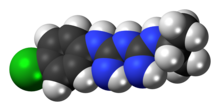프로과닐
Proguanil | |
 | |
| 임상 데이터 | |
|---|---|
| 상호 | 팔루드린 기타 |
| 기타 이름 | 클로르구아니드, 클로로구아니드[1] |
| AHFS/Drugs.com | Micromedex 상세 소비자 정보 |
| 루트 행정부. | 입으로 (태블릿) |
| ATC 코드 | |
| 법적 상태 | |
| 법적 상태 |
|
| 약동학 데이터 | |
| 단백질 결합 | 75% |
| 대사 | 간(CYP2C19) |
| 대사물 | 시클로구아니일 및 4-클로로페닐비구아니드 |
| 반감기 제거 | 12~21시간[2] |
| 식별자 | |
| |
| CAS 번호 | |
| PubChem CID | |
| 드러그뱅크 | |
| 켐스파이더 | |
| 유니 | |
| 케그 | |
| 체비 | |
| 첸블 | |
| CompTox 대시보드 (EPA ) | |
| ECHA 정보 카드 | 100.007.196 |
| 화학 및 물리 데이터 | |
| 공식 | C11H16클론N5 |
| 몰 질량 | 253.73 g/g−1/g |
| 3D 모델(JSmol) | |
| 녹는점 | 129 °C (264 °F) |
| |
| |
| (표준) | |
클로르구아니드와 클로로구아니드로도 알려진 프로구아닐은 말라리아를 [3][4]치료하고 예방하기 위해 사용되는 약이다.클로로킨이나 아토바콘과 [4][3]함께 자주 사용된다.클로로킨과 함께 사용하면 가벼운 클로로킨 내성 [3]말라리아를 치료할 수 있습니다.입으로 [4]먹는 거예요.
부작용으로는 설사, 변비, 피부 발진, 탈모,[3] 가려움 등이 있습니다.말라리아는 임신 중에 더 심각한 경향이 있기 때문에, 일반적으로 유익성이 [3]위험성보다 더 크다.임신 중에 사용할 경우 [3]엽산과 함께 복용해야 합니다.그것은 모유 [3]수유 중에 사용해도 안전할 것 같다.프로구아닐은 간에 의해 활성 대사물인 사이클로구아닐로 [4]전환된다.
Proguanil은 적어도 [5]1945년부터 연구되어 왔다.그것은 세계보건기구의 필수 [6]의약품 목록에 있다.미국과 캐나다에서는 atovaquone/proguanil의 [7]조합으로만 사용할 수 있습니다.
의료 용도
프로구아닐은 특히 클로로킨 내성 P. 팔시파룸 말라리아가 보고된 지역에서 어른과 어린이 모두의 말라리아 예방과 치료에 사용된다.그것은 보통 또 다른 말라리아 [8]치료제인 아토바콘과 함께 복용된다.
그것은 또한 대부분의 다른 다제내성 P. 팔시파럼의 치료에도 효과적이다. 성공률은 93%[9]를 넘는다.
부작용
프로구아닐은 일반적으로 잘 견디며, 대부분의 사람들은 부작용을 경험하지 않는다.그러나 일반적인 부작용으로는 복통, 메스꺼움, 두통, 발열 등이 있다.프로그와닐을 음식과 함께 먹으면 이러한 부작용을 [10]줄일 수 있다.Proguanil은 심각한 신장 장애가 있는 사람, 임산부 또는 5kg [11]미만의 모유 수유를 하는 여성이 복용해서는 안 됩니다.또한 [12]간 효소의 수치가 증가했다는 보고도 있어 치료 완료 후 최대 4주 동안 높은 수준을 유지할 수 있다.
메커니즘
프로구아닐은 단독으로 사용될 때 프로드러그 역할을 한다.활성 대사물인 사이클로구아닐은 디히드로폴산 환원효소(DHFR)[13]의 억제제이다.포유류와 기생충 모두 DHFR을 생성하지만, 사이클로구아닐의 억제 활성은 기생 DHFR에 특이하다.이 효소는 엽산 순환의 중요한 구성요소이다.DHFR의 억제는 기생충이 디히드로폴산을 테트라히드로폴산(THF)으로 재활용하는 것을 막는다.THF는 DNA 합성, 아미노산 합성 및 메틸화에 필요하며, 따라서 DHFR 억제는 이러한 [14]과정을 차단한다.
Proguanil은 항말라리아성 아토바콘과 함께 사용하면 상승효과를 보인다.이 작용 메커니즘은 프로구아닐이 단일 약제로 사용되었을 때와는 다릅니다.이 경우, DHFR 억제제로서 기능하는 것으로 생각되지 않는다.프로구아닐의 첨가는 아토바콘에 대한 저항을 감소시키고 미토콘드리아 아포토시스 [15]캐스케이드를 트리거하는 아토바콘의 능력을 증가시키는 것으로 나타났다.이것은 일반적으로 "미토콘드리아 막 [16]전위의 붕괴"라고 불립니다. 프로구아닐은 미토콘드리아 [17]막의 투과성을 증가시키는데 필요한 아토바콘의 유효 농도를 낮춥니다.
레퍼런스
- ^ Mehlhorn, Heinz (2008). Encyclopedia of Parasitology: A-M. Springer Science & Business Media. p. 388. ISBN 9783540489948. Archived from the original on 2016-12-20.
- ^ "Malarone (atovaquone/proguanil) Tablets, Pediatric Tablets. Full Prescribing Information" (PDF). GlaxoSmithKline. Research Triangle Park, NC 27709. Archived (PDF) from the original on 20 September 2016. Retrieved 14 July 2016.
- ^ a b c d e f g World Health Organization (2009). Stuart MC, Kouimtzi M, Hill SR (eds.). WHO Model Formulary 2008. World Health Organization. pp. 199, 203. hdl:10665/44053. ISBN 9789241547659.
- ^ a b c d "Atovaquone and Proguanil Hydrochloride". The American Society of Health-System Pharmacists. Archived from the original on 20 December 2016. Retrieved 8 December 2016.
- ^ Nzila, Alexis (2006-06-01). "The past, present and future of antifolates in the treatment of Plasmodium falciparum infection". Journal of Antimicrobial Chemotherapy. 57 (6): 1043–1054. doi:10.1093/jac/dkl104. ISSN 0305-7453. PMID 16617066.
- ^ World Health Organization (2019). World Health Organization model list of essential medicines: 21st list 2019. Geneva: World Health Organization. hdl:10665/325771. WHO/MVP/EMP/IAU/2019.06. License: CC BY-NC-SA 3.0 IGO.
- ^ "Proguanil". www.medscape.com. Medscape. Archived from the original on 9 November 2016. Retrieved 8 November 2016.
- ^ "Malaria: MedlinePlus Medical Encyclopedia". medlineplus.gov. Archived from the original on 2016-11-17. Retrieved 2016-11-16.
- ^ Boggild, Andrea K.; Parise, Monica E.; Lewis, Linda S.; Kain, Kevin C. (2007-02-01). "Atovaquone-Proguanil: Report from the Cdc Expert Meeting on Malaria Chemoprophylaxis (ii)". The American Journal of Tropical Medicine and Hygiene. 76 (2): 208–223. doi:10.4269/ajtmh.2007.76.208. ISSN 0002-9637. PMID 17297027.
- ^ "Atovaquone And Proguanil (Oral Route) Side Effects - Mayo Clinic". www.mayoclinic.org. Archived from the original on 2016-11-09. Retrieved 2016-11-08.
- ^ Prevention, CDC - Centers for Disease Control and. "CDC - Malaria - Travelers - Choosing a Drug to Prevent Malaria". www.cdc.gov. Archived from the original on 2016-11-13. Retrieved 2016-11-08.
- ^ Looareesuwan, S.; Wilairatana, P.; Chalermarut, K.; Rattanapong, Y.; Canfield, C. J.; Hutchinson, D. B. (1999-04-01). "Efficacy and safety of atovaquone/proguanil compared with mefloquine for treatment of acute Plasmodium falciparum malaria in Thailand". The American Journal of Tropical Medicine and Hygiene. 60 (4): 526–532. doi:10.4269/ajtmh.1999.60.526. ISSN 0002-9637. PMID 10348224.
- ^ Pubchem. "proguanil C11H16ClN5 - PubChem". pubchem.ncbi.nlm.nih.gov. Archived from the original on 2016-11-14. Retrieved 2016-11-13.
- ^ Boggild, Andrea K.; Parise, Monica E.; Lewis, Linda S.; Kain, Kevin C. (2007-02-01). "Atovaquone-Proguanil: Report from the CDC Expert Meeting on Malaria Chemoprophylaxis (ii)". The American Journal of Tropical Medicine and Hygiene. 76 (2): 208–223. doi:10.4269/ajtmh.2007.76.208. ISSN 0002-9637. PMID 17297027.
- ^ Srivastava, Indresh K.; Vaidya, Akhil B. (1999-06-01). "A Mechanism for the Synergistic Antimalarial Action of Atovaquone and Proguanil". Antimicrobial Agents and Chemotherapy. 43 (6): 1334–1339. doi:10.1128/AAC.43.6.1334. ISSN 0066-4804. PMC 89274. PMID 10348748.
- ^ Srivastava, Indresh K.; Rottenberg, Hagai; Vaidya, Akhil B. (1997-02-14). "Atovaquone, a Broad Spectrum Antiparasitic Drug, Collapses Mitochondrial Membrane Potential in a Malarial Parasite". Journal of Biological Chemistry. 272 (7): 3961–3966. doi:10.1074/jbc.272.7.3961. ISSN 0021-9258. PMID 9020100.
- ^ Thapar, MM; Gupta, S; Spindler, C; Wernsdorfer, WH; Björkman, A (May 2003). "Pharmacodynamic Interactions Among Atovaquone, Proguanil and Cycloguanil against Plasmodium falciparum in vitro". Transactions of the Royal Society of Tropical Medicine and Hygiene. 97 (3): 331–7. doi:10.1016/S0035-9203(03)90162-3. PMID 15228254.
외부 링크
- "Proguanil". Drug Information Portal. U.S. National Library of Medicine.


